(On the occasion of Gandhi Jayanti)
India is once again poised to celebrate the birthday of Mohandas Gandhi today, on October 2nd as, it has done so over the previous seven decades. The official importance of Gandhi Jayanti is underscored by the fact that it is one of only three national holidays, alongside Independence Day and Republic Day. The President and Prime Minister set the example for the prescribed set of rituals on this auspicious day. We can be certain that wreaths of flowers will be laid at Rajghat, the simple yet elegant and moving memorial to the architect of Indian independence, and dignitaries will bow in reverence to the ‘Father of the Nation’. There will be the usual speeches pointing to the sacrifices made by Bapu, as Gandhi was known in his lifetime to fellow Indians, and exhortations, especially to the young, to take some lessons from Gandhi’s life and dedicate themselves to the task of nation-building.

Prime Minister Narendra Modi at Rajghat, 2 October 2017. Source: Twitter Account of Modi.
The country’s Prime Ministers have in the past spent a few minutes at the spinning wheel on Gandhi Jayanti, once again in a show of leading the country and in an effort to demonstrate that their understanding of Gandhi is not entirely hollow. Narendra Modi will doubtless do the same; however, as he is given to theatrics and gifted the country the slogan of ‘Swachh Bharat’, it is very likely that he will also pick up a broom. (As an aside, one can say that the leaders of India are very much in need of brooms to sweep the cobwebs that have cluttered their minds.) A touch of humility, even if for a few minutes, is always calculated to make the powerful feel invincible. Outside the capital, elsewhere in India, the same protocols will be followed with some variations: Governors and Chief Ministers will place garlands around Gandhi’s statues, homilies will be sung to the great man, and Bapu’s favorite bhajans may be sung by choirs of young women and women dressed in khaddar.

Chief Minister of Bihar, Nitish Kumar, garlanding a portrait of Gandhi in the capital Patna on October 2nd, 2017. Photo: Press Trust of India.
Once the country is past all this, a few hours after sunrise, the politicians, functionaries of the state, and the pracharaks of the RSS will get down to the business of doing what they do best these days—aiding the killers of Gandhi and ensuring that absolutely nothing that is viable in Gandhi’s thought survives. The phrase, “killers of Gandhi”, especially in reference to events in the present may strike those who thought that Gandhi was assassinated on 30 January 1948 as obtuse. That evening, Nathuram Godse, a Chitpavan Brahmin from Pune, plugged three bullets into Gandhi’s body and the Mahatma died almost instantly. The Government of India claimed that Godse was part of a larger conspiracy to kill Gandhi: eventually, after a long drawn-out trial, Godse and Narayan Apte were convicted on charges of murder and sent to the gallows. Nathuram’s brother, Gopal Godse, was among those who received a prison sentence. Vinayak Savarkar, the alleged mastermind of the conspiracy, was acquitted. Savarkar had a special gift for being able to have others do his dirty work: he wriggled out of many a difficult situation during the course of his political career, and would doubtless have been happy that younger, more virile, and certainly more gullible men were available to shoulder the work of political assassination. Today his portrait hangs in Parliament House.

A Largely Cheerful Lot of Conspirators, and a (characteristically) Morose Mastermind: Nathuram Godse and Friends at their trial for the Murder of Gandhi at the Red Fort, Delhi, 22 June 1948. Left to Right, Front to Back: Nathuram Godse, Narayan Apte, Vishnu Karkare, Digambar Badge (approver), Madanlal Pahwa, Gopal Godse, Shankar Kistayya, V. D. Savarkar, and Dr. Parachure (hidden).

The statue of Gandhi in Thaliparambha, in north Kerala’s Kannur district, after vandals hurled stones and bottles, damaging the spectacles. Photo: Hindustan Times.
In speaking of the “killers of Gandhi”, I do not advert even remotely to Nathuram Godse and his friends and associates who had sworn their allegiance to the idea of an undivided India in which the Hindu would reign supreme. One of Gandhi’s more perceptive biographers, Robert Payne, wrote about the killing of Gandhi as a “permissive assassination”. His submission, quite simply, was that though Nathuram Godse fired the fatal shots, a great many among the middle class desired Gandhi’s death. Some viewed Gandhi as authoritarian, though that was scarcely their objection: more importantly, he struck the aspiring middle and upper classes, who saw the independence of India as an opportunity to advance their careers and create economic opportunities and wealth for themselves, as an obstructionist who was out of sorts in the modern world. The old man had already become obsolete and dispensable, and Nathuram was not mincing words when, at his trial, he spoke bitterly and mockingly of Gandhi’s fasts, spinning, his ‘inner voice’, and the Mahatma’s other mannerisms which, in Nathuram’s view, had effeminized Indian politics and would have made India incapable of a muscular response to attacks in a world where nations vie for advantage and supremacy. Gandhi had to die if India were to survive.
What Nathuram did not at all understand was that men such as Gandhi have to be shot dead repeatedly. It is not only that a Gandhi can be killed in the flesh but not in the spirit. That is only one, and the more predictable, part of the story. The spectre of Gandhi is everywhere and October 2nd is not the only day when he looms large, except of course to those who are unpleasantly reminded by his birth anniversary of the fact that there is much work still to be done in eviscerating Gandhi from the public sphere. Even those who do not care an iota for him have to invoke his name; love him or hate him, he is inescapable. He is everywhere, on billboards, mugs, tee-shirts, car stickers, murals, graffiti, television ads, cartoons, and much else. The present-day killers of Gandhi can, however, live with the merchandizing of Gandhi, and nearly all of them, even as they despise him, would have no reluctance in capitalizing on his name. The idea of cultural capital may be a conceptual black hole to them, but they instinctively understand that the invocation of Gandhi’s name can open many doors in the right places.
What is, then, truly worrisome to the killers of Gandhi is that, much like the obdurate old man, some of Gandhi’s ideas refuse to go away. Nathuram Godse and his implicit patrons must have hoped and certainly thought that Gandhi, a few years after his assassination, would become a distant memory. Quite to the contrary, much of the contemporary global common sense about, for example, the hazards of unchecked consumption, the problems that inhere in the very idea of the nation-state, and the inverse relationship of militarism to well-being is anticipated in the life and writings of Gandhi. The so-called “toxic masculinity” that is on witness in the streets of every town and city in India is not only a manifestation of Hindu rage and a will to shape a decisive understanding of the past but also a reaction to the androgynous values that Gandhi embodied and which the Hindu nationalist tacitly knows are enshrined in Indian culture. What is different about the killers of Gandhi today is that act with total impunity. They are aware of the fact that the present political dispensation is favorable to them, and that much of the ‘ruling class’ despises Gandhi. The mandarins who stalk the corridors of power and sit on corporate boardrooms know that all they have to do is hold a conference every now and then on “the relevance of Gandhi” to cover up for the complete contempt and even hatred they harbor for the “Mahatma”. That is, of course, why middle class Indians think nothing of circulating poems—I hope to discuss one in the next few days—on What’s App describing Gandhi as a fool and traitor to the nation, and why they think that his assassin should be installed as a deity in a temple.
One could go in this vein, but this much is clear: Nathuram botched the assassination. This is why the killers of Gandhi are still on the loose, making hay while the sun shines. The official pieties surrounding Gandhi Jayanti may be nauseating to behold, but October 2nd is a necessary provocation.
There are numerous other essays on Gandhi on this blog; readers might find especially interesting the following essays:
*The Homeless Gandhi
*A Reputation, and More, in Ruins: Gandhi at the Aga Khan Palace, Pune
*Vaishnava Janato: Gandhi and Narsi Mehta’s Conception of the Ideal Person
*A Strange Case of Doppelgangers: Hitler and Gandhi in India
*Gandhi’s Photograph and the Politics of the Frame
*Gambling on Gandhi: On Being Timid and Taking Risks
*Gandhi’s ‘Relevance’: One More Round of Humbug




















